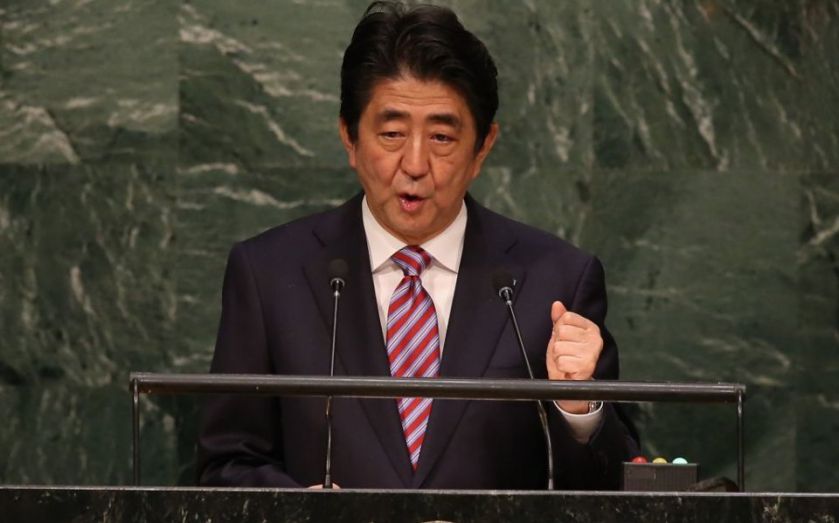Japan: Three years after the Abenomics’ bazookas were fired, the jury’s out on whether the economy is better off – but investors are cheering the Nikkei’s rise

As he launched the bazooka that would lift Japan’s economy out of decades of stagnation, Prime Minister Shinzo Abe told the world he was firing “three arrows” of “bold policy” which would finally “achieve results”.
Three years on, and the jury’s still out on whether Abenomics is showing signs of success.
THE PROBLEMS
Economically speaking, Japan’s problems are many-faceted. It suffered frequent recessions while prices fell in a deflationary spiral. The yen was strong and refused to be weakened, making the country’s manufactured goods seem unattractive overseas. With a high proportion of the population elderly, there are too few youngsters to do the work and companies struggle to find staff.
In business terms the pace of change is glacial, owing to Japan’s hierarchical, authoritarian culture. Big business has been inefficient and wasteful, and creating value for shareholders has not been management’s primary concern.
One of the reasons Japan has been economically stagnant is that, despite the above, it has virtually no unemployment and a good standard of living. So most ordinary Japanese people don’t care whether the economy is growing.
“Japan is like a contented frog luxuriating in a warm bath, unable to understand that the water is being heated toward boiling point from several gas jets,” wrote Kevin Rafferty in The Japan Times.
THE CURE
Given the scope of the economic problems, Abenomics is hugely ambitious and aims to achieve everything from encouraging a higher birthrate, to investing in new infrastructure, raising inflation to 2 per cent and expanding GDP by 22 per cent to ¥600 trillion (£3 trillion). Other parts of the plan include cementing trade partnerships, encouraging women to work and creating 600,000 new jobs.
The cornerstone of the strategy is a massive QE programme of ¥80 trillion (£437bn) in annual asset purchases – 10 times the US’s. Two other arrows take in government spending and structural or cultural reform.
TAKING STOCK
It is a grand plan but as is often the case with economics, the picture is as clear as mud. The death knell for Abenomics seemed to have been sounded in November, when third-quarter data showed the economy slid into a technical recession with a contraction of 0.8 per cent.
It was the fifth recession in seven years, dubbed a “quintuple dip”, and commentators said it was proof that Abenomics is faltering.
Bearing in mind that, between 1992 and 2008, Japanese governments embarked on 18 stimulus packages, according to the Japan Times, it’s easy to see why people are sceptical.
“Japan will never recover. They are demographically shot. They will just wander along with no inflation or growth,” argues James Barrineau of Schroders.
There have also been signs that the Bank of Japan may expand its already-giant QE programme. “The Japanese economy is in a static situation. It is not growing positively,” said Etsuro Honda, a key adviser to Abe.
SIGNS OF SUCCESS
Then the data was revised last week to show, actually, the economy grew by 1 per cent that quarter. So there was no recession.
“There is a difficulty with all GDP statistics… The swing in the revisions is a problem for policymakers and one which the Bank of Japan has to contend with,” explains David Page of Axa Investment Management.
There is a similar issue with inflation. A new, higher sales tax was put in place, which had the effect of distorting inflation figures and making it difficult to see if Abenomics is stimulating prices. “It is hard to look at the trend because there was an impact from the sales tax… But it does seem there is an underlying pick-up in underlying inflation,” Page says.
The trouble with comparing now with the past is that it’s always difficult to know what would have been – could Japan have been worse without Abenomics?
CULTURE SHIFT
One area where change does seem to be bubbling up is in the corporate sphere. A stock market index ranking Japan’s companies on a range of shareholder-friendly measures such as efficient use of capital was launched. Called the JPX-Nikkei 400, it aims to showcase the most investment-worthy of Japanese companies. There has been a clamour to be included, with some companies openly stating they intended to shape up to join the elite grouping. “Corporate Japan wants to be included, as it’s a loss of face if it isn’t,” says David Coombs of Rathbones. “I was a massive sceptic of that but I think I was wrong.”
Historically Japanese companies have been reluctant to return cash to shareholders through dividends and share buy-backs, preferring to sit on giant sums instead. Today, the 1,800 companies on the stock market have a cash hoard of ¥80 trillion (£500bn), says Darius McDermott of Chelsea Financial Services. He says Japanese corporations are becoming more shareholder friendly and are growing their annual dividends faster than anywhere else in the world.
Global investors also cheered Abenomics for its positive effect on the stock market. Cash has flooded into the market, firstly on the expectation that QE would cause Japanese asset prices to rise as it did in other markets, but latterly on hopes companies will be better run in future.
The Nikkei 225 has risen over 100 per cent in the last three years and is expected to rise further next year. This is also because the Bank of Japan may expand its QE programme in the spring.
“Toyota, Fuji Heavy, Toray, Kao, Kose and JR Central are the stocks to watch next year, as sectors exposed to US auto sales, aviation, and inbound tourism are set to benefit from improved conditions in the States,” says Genzo Kimura of SuMi Trust.